Transformer Talk
Audio transformers are an interesting part of the signal path. They come from the earliest days of audio technology when there was no other practical way to interface high impedance tube circuits with low impedance input and output devices like microphones and loudspeakers.
In the beginning, Electrical Engineers simply wanted the most transparent device they could make to accomplish this impedance transformation. However in the real world of engineering there are always trade-offs to be made. So we see that a transformer's design, core materia, core design and windings all have an impact on the sound. Transfomer manufacturers therefore have to adjust the variables to optimize transfomers for different jobs.
Tube Condenser Microphone output transformers required a a high input to ouput impedance ratio. In other words a lot of transformation has to go on. This means that there should be very low stray capacitance between the coils so that the sound travels through the magnetic path. Stray capacitance provides an alternate path around the coils that as we shall see can impact the audio response. Microphone output transformers also require very flat and wide frequency response. Typically from 10Hz to well past 30Khz. The response should fall off gracefully at both ends to minimize phase shifts. They also should show very low distortion across that entire audio range.
In this discussion we are going to look three microphone Transformers in actual microphones:
- Cinemag CM-2480
- Peluso BV11P
- APEX 450 original transformer
The results are a little surprising in that the least expensive transformer from APEX does a pretty good job.
For those who really want the "down low" on transformers the people at Jensen have some of the best literature (and some of the best transformers). Bill Whitlock has written an excellent papers on Audio Transfomers that you can find here.
A Look at Frequency Response
Cinemag CM-2480 driven by parallel 6072, with 1uF cap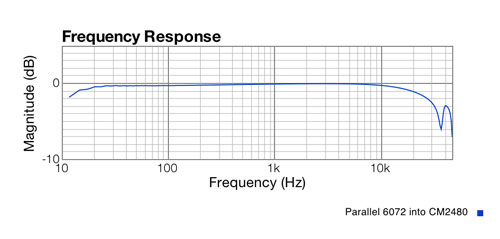
The Cinemag CM-2480 has great Bass Response but suffers a little at the top end. Down 1dB at 20Khz, seems too much for pro audio. But it can tame a really bright capsule like a CEK12 and create an m251 type microphone. It also shows some wierd dip at 34Khz and bump at 40Khz. We suspect this is the effect of stray capcitance coupling.
Peluso BV11P, parallel Triodes, with 1uF cap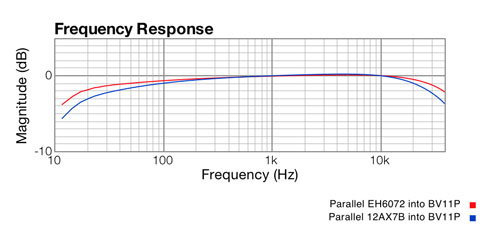
The BV11P from peluso has better HF response than the Cinemag but suffers in the bottom end when you drive it with a 6072 plate follower, even with both triodes running in parallel. And if you happen to use a 12AX7 tube look out! The high plate resistance of that tube cannot drive the lower impedance input impedance the BV11P. You lose on both ends!
Do it Yourself Surprise!
Ok how many of you reading this have bought a fancy new capsule and a BV11P transformer, a new tube and a new output CAP and put them into your APEX 460? You were sure you improved the microphone right? Well look at what you did to the response of the preamp circuit in your microphone in the graph below.
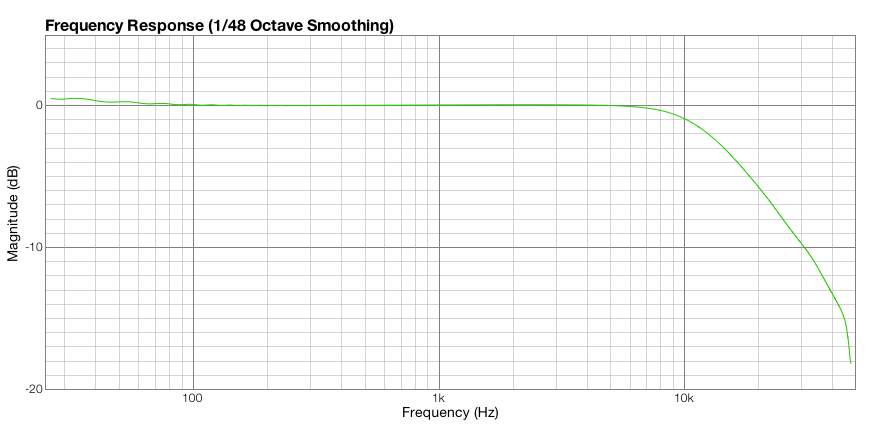 Stock APEX 460 with BV11P transformer
Stock APEX 460 with BV11P transformer
Would you by audio gear the started to roll-off at 8Khz? That was considered good in oh... about 1935!
Just so you see my point; below is the response of a Wagner 47 Internal Pre-amp, measured from 20Hz to 40Khz. And although it's hard to read it, the vertical scale of the graph is the same. The graph shows 25 dB from top to bottom.
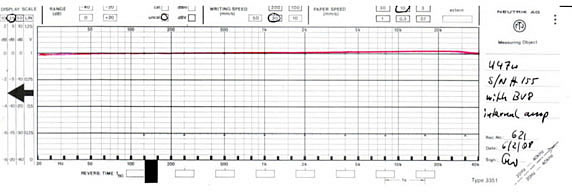 u47 #H155 internal preamp response with BV8 xfmr. 20Hz to 40Khz
u47 #H155 internal preamp response with BV8 xfmr. 20Hz to 40Khz
To see the original at Wagner Microphones click here
Click through to the section Called Transfomers, bottom of the page.
Now look what happens when you drive the BV11P with the a properly modified APEX 460!
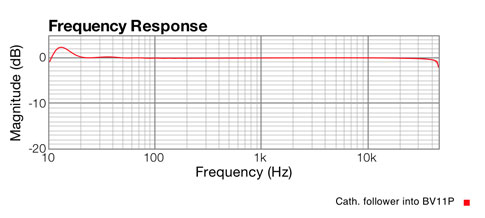 FAR "12" ( APEX 460) with BV11P response from 10Hz to 45Khz
FAR "12" ( APEX 460) with BV11P response from 10Hz to 45Khz
Looks pretty much like the u47 now doesn't it?
The low impedance Cathode Follower output in the 460 drives the BV11P flat from 20Hz right past 40KHz. The sharp dip at 45Khz is caused by my "state of the art" digital audio unit not the old fashioned tube mic. :-)Note: The 2.5dB bump in the bass below 20Hz is due to the high value (270K) resistor used in the APEX 460. It does not affect the sound negatively in our opnion but it can be corrected with a 47K damping resistor directly across the transformer primary. You loose about 1 dB of output that way.
Cinemag likes the Cathode Follower Too!
And look how the little Cinemag CM-2480 changes when you drive it with the cathode Follower in the Fox Audio Research "Standard 12" microphone. Notice that unlike the Peluso it has high frequency roll-off above 20Khz. This can be helpful with capsules that are too "edgy" in the top end.
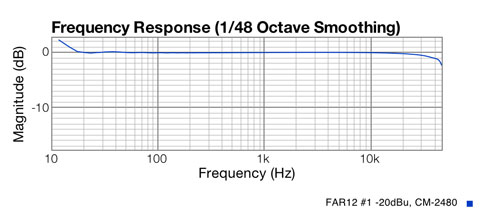
Cinemag/Peluso Distortion Comparison
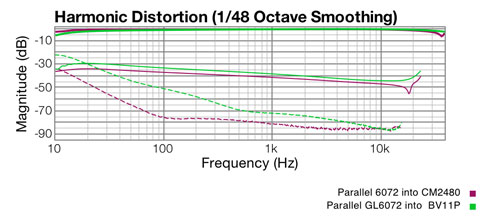
Same mic and tube were used to measure distortion. The input level to the mic. was -20dBu applied to the grid. You can see the Cinemag has a little better 2nd harmonic distortion but much lower 3rd harmonic (dotted line) distortion below 500Hz. It is important to note that the Peluso is putting out about 6dB or so more signal due to it's transformer ratio. (5:1 vs 10.5:1 for the CM2480)
And below is the Cathode Follwer distortion with the BV11P compared to a plate follower circuit.
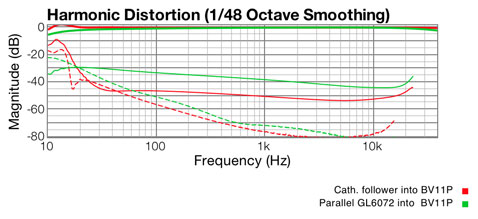
You can clearly see the BV11P likes to be driven with the lower impedance output. Distortion is much lower than the with the "plate follower" circuit. However we can see more subsonic distortion below 20Hz. This because the cathode follwer is driving the transformer harder down there due to it's lower output impedance. For your reference, the plate follower circuit is used in the vintage microphones like the c12 or m251.
Ditto for Cinemag
And the 2nd Harmonic distortion (Solid line below) with the CM-2480 looks 5 dB better when working with the cathode follower circuit but not quite as low as the BV11P. Interestingly 3rd Harmonic distortion (dotted line) is higher below 2Khz than with the ordinary plate follower circuit but again not quite as low as the Peluso in the same circuit.
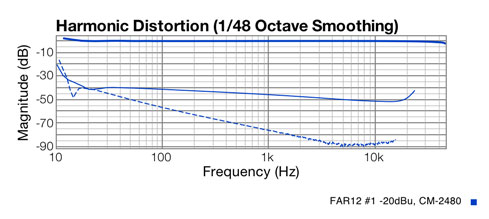
What about the APEX Transformer?
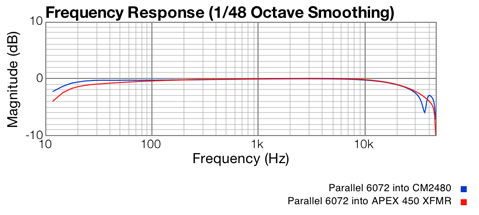
The graph above shows an APEX 450 transformer compared to the CM-2480. (The unit used in the APEX450 was a little bit better than what is used in the APEX460 but they are similar.)
We can see the APEX has about the same HF response, minus the wierd thing at 34KHz, but it is a little light in the Bass department. But it's not too shabby for a cheap transformer.
APEX Distortion Measurements
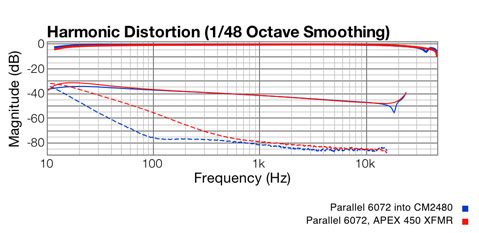
When we compare the APEX distortion we can see that 2nd Harmonic distorion (solid lower line) almost the same as the Cinemag. The Cinemag walks away with the prize below 1K with 3rd Harmonic distortion, which is the non- musical kind.
Ya But How Do They Sound?
Our ears tell us the sound of BV11P agree with the graphs when used in the APEX 460 and TCM1200 style mics that have a Cathode Follower output. The CF circuit has no problem driving the lower impedance BV11P and you get flat wide sound response and 6 dB more output too! It sounds amazing on our 12 and m251 mics.
Warning: NEVER use a 12AX7 tube to drive a BV11P. It sounds nasal and "lo-fi". Look at the graph above. No bass and no treble.
The Cinemag CM-2480 is a great fit to a grounded cathode circuit (plate follower). The higher turns ratio (10.5:1) is less load on the tube and so the Bass is flat down to 16Hz. But remember, for this transformer the tube amp must have an output impedance lower than 16,000 ohms. A single 6072 for example is not up to the job unless you want some heavy duty roll off. Putting both tube in parallel, as shown here, gets you down to 10,000 ohms.
The top end can be a problem the way is drops 1dB at 20Khz with a both halves of a 6072 triode driving it. This is clearly audible. It adds "warmth" but if used with an already "warm" capsule like a K47, it can sound dull. We tried it. Be warned.
Using the Transformer as EQ
An interesting design can be made by purposely coupling the tube and transformer so that the high end rolls off. This creates EQ which can compensate for a capsule with too much top end lift like a CEK12. We built our generation of the FAR c12+ this way using a T14 transformer to smooth out the top end and lighten up the low end.
Warning: Some chinese mics are now being shipped with an extreme version of this. Look at this response of a brand new Nady 1050 recently picked up from EBAY.

In our opinion these transformers are a poor way to reduce the high frequency lift in the 32mm capsule. We get better results by using a small "tone capacitor" on the tube output. It's way more phase linear, has less distortion and just generally doesn't destroy the integrity of the internal mic preamp.
Editors Note On the CM-2480, July 12, 2010
And now we have tested and listened to the CM-2480 in our "Standard 12" microphone and it sounds great too as long as we drive it with the CCDA amplifier.
It's amazing that you can actually hear the difference between the Peluso and the Cinemag even though the response difference happens above 20Khz. The Cinemag with that tiny amount of High frequency roll off smooths out the sound of a little and makes a very nice mic. We can't say it is better or worse. It's just different and a touch smoother. Not quite as smooth as our "m251" but moving in that direction.
Conclusion
From what we see here, it is a reasonable option for the budget home studio to forego the cost of a new transformer in your microphone upgrade. The simple APEX unit provides pretty flat response and low distortion. If you listen to the FAR 47 sound samples this is a standard APEX 450 mic and transformer using our FAR 47 circuit with a Peluso K47 capsule. Sounds pretty good!
And about the dreaded Cathode Follower (CF) circuit ...
When you are driving a transformer with a little tube that has high Plate Resistance (Rp) it is more difficult to get really flat response across the entire audio range even when we wired both 6072 triodes in parallel to lower Rp in half!
The cathode follower contrary to many does not fix a bad transformer. As we saw above each transformer showed some roll off; even the very fine quality units from Peluso and Cinemag. The CF circuit fixes an inherent problem with the plate follower circuit; high output impedance. By using a CF output circuit we do the first "transformation" in the tube and amplify the current we can deliver. The transformer then does the final step down to mic levels and balances (floats) the output signal.
Check out our little article on the Constant Current Draw Amplifier (CCDA). That's the real name of the innovative circuit used in the in the ALTRON Chinese made microphones.
Which transfomer you choose and which output circuit you choose like all audio engineering decisions, depends on what you want to accomplish and the trade offs you are prepared to make.
Fortunately, as we can see there are a number of excellent options to choose from.
If you have any questions about transfomers send us a note at:
